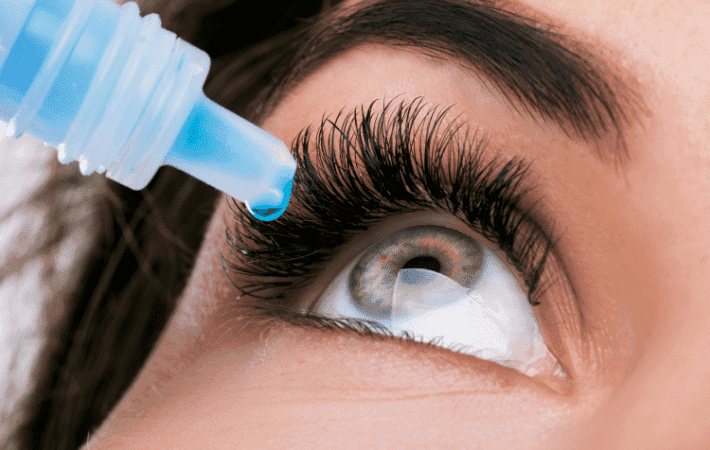Our eyes are naturally designed to tear. Our tears provide lubrication to keep our eyes comfortable and moist, but sometimes we don’t produce enough tears or tears of sufficient quality to keep our eyes working the way they’re supposed to. This can lead to a condition called dry eye.
Dry eye can be painful and harmful if left untreated. Fortunately, there are many ways to obtain dry eye relief.
If you think you may be suffering from this condition, along with an estimated 49 million Americans, talk to your eye doctor to receive a proper diagnosis.
What Is Dry Eye?
Dry eye syndrome is defined as a long-term lack of lubrication and moisture on the eye’s surface, but the condition also affects people temporarily.
Our tears are made up of three components, and an adequate and consistent layer of tears is necessary to keep your eyes healthy, comfortable, and seeing well.
These three components are:
- The oily layer produced by meibomian glands
- A watery (aqueous) layer produced by lacrimal glands
- A mucous layer produced by goblet cells in the conjunctiva of the eye
Each component of the tear film serves an essential purpose. A lack of any of these components can lead to the two types of dry eye.
Aqueous Tear Deficiency
Aqueous deficient dry eye occurs when there is an inadequate aqueous layer in the tear film. When this happens, your eye can’t produce enough tears to keep your eyes moist and functioning correctly.
Evaporative Dry Eye
Evaporative dry eye is the most common form of dry eye and occurs when there is a lack of the lipid or mucous layer present in your tears. Without these layers, your tears evaporate too quickly, causing the eyes to dry out.
Causes of Dry Eye
A variety of factors can cause dry eyes. Some of the many potential causes of dry eyes include:
- Prolonged computer use
- Poorly fitted contact lenses
- Ageing
- Menopause
- Certain medications such as antihistamines, birth control pills and blood pressure medication
- Dry or windy environments
- Air travel
- Smoking
- Health conditions such as Sjögren’s syndrome, rheumatoid arthritis, and lupus
- LASIK or other eye surgeries
- Wearing a mask
- Allergies
- Eye conditions like meibomian gland dysfunction and blepharitis
Symptoms
Because Dry Eye Syndrome has many different causes, symptoms can vary greatly as well. Symptoms of dry eye can affect one or both eyes and include:
- Burning, aching or itchy eyes
- Fatigued eyes
- Eye redness
- Eye dryness
- Photophobia (light sensitivity)
- Feeling like something is in your eye
- Blurred vision
- Mucus in or around the eyes
- Difficulty with vision, especially at night
- Abnormally watery eyes
- Discomfort when wearing contact lenses
When Should You See Your Eye Doctor?
You should see your eye doctor if you’ve had any prolonged or severe symptoms. Your eye doctor can take steps to diagnose your issue and recommend treatment plans.

Treatments
Medications and Supplements
One of the most common ways to treat dry eye is through over-the-counter eye drops, called artificial tears. Artificial tears moisten your eyes to relieve your symptoms.
If over-the-counter eye drops are not a suitable treatment option for you, your eye doctor may prescribe a medication to treat your dry eye. These medications may be given orally or as eye drops and can reduce inflammation of your eyelids or stimulate oil production in your tears.
In addition to medication, certain oral supplements, such as fish oil and omega-3 fatty acids, can help to improve the quality of your tear film.
Medical Procedures
Medical procedures that can treat dry eye include:
- Punctual plugs- If medications or supplements don’t offer you relief, eye inserts might be an option. These small plugs of medication (about the size of a grain of rice) go into your eye like contacts and release medicine gradually to keep your eye moist.
- Lipiflow- Your eye doctor may recommend a procedure known as LipiFlow. This procedure is an FDA-approved device that heats and massages your meibomian glands, dissolving blockages that may be causing tear production issues.
Lifestyle Changes
In addition to medical treatments, some at-home changes you can make may improve the symptoms and risk factors associated with dry eye. These include:
- Wearing sunglasses to protect tears in certain environments
- Taking screen-time breaks and remembering to blink often when doing the same task for a long time
- Avoiding dry climates or use an air-humidifier when needed
- Drinking a sufficient amount of water
- Eating a diet high in certain vitamins and minerals
- Avoiding smoking
Dry Eye Tests and Diagnosis
The only way to know if you suffer from dry eye disease is by getting a comprehensive eye exam from your eye doctor.
A typical eye exam to diagnose dry eye disease includes the following steps:
- Your eye doctor will go over any questions or concerns you have related to your eyesight and overall vision health
- They will then go over your health history to determine any underlying causes or factors that may be contributing to your condition
- Your eye doctor will conduct a regular eye exam and take additional steps if dry eye is a concern, including measuring the volume of your tears and the quality of your tears.
If you are concerned about dry eye, contact us today to find the solutions you need to get back to seeing comfortably!


